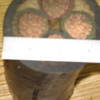Hello: Is it good practice to use my bench buffer on small items for buffing out wax? The wheel now has red rouge on it so I guess I’ll need one exclusively for buffing. While were on the subject of wax; when I opened my can of Buffalo wax there was an amount of liquid in the bottom which I dumped out, should I have stirred it back in? The can has a small hole in the lid but I left the rag in the can so it would have blocked any evaporation, more or less. Do most WWers use wax as the last coat on most everything?
Thanks all, KDM
The Bill of Rights
December 15 1791
NRA Endowment Member
LEAA Life Member
CRPA Member
















Replies
wax makes an excellent protective coat for delicate films like shellac, or any open grain finish that is going to see some human contact like a rubbed oil. kind of like a barrier coat that can be reapplied and fixed much more easily than the finish you just painstakingly applied. i recently re-shellacked a dining room table. there was already shellac on it and the customer just wanted a few problem spots sorted out. i explained that i couldn't ethically walk away from a dining room table with shellac on it without waxing it, one spilled drink and blammo- i'm getting called back. for heartier finishes like poly or spar or lacquer it's unnecessary.
honestly i've never tried to buff out a piece tiny enough as would require a bench buffer, and i usually prefer to buff by hand.
as for the liquid, was it in the bottom of the can or on top of the wax? more than likely it was the thinner used to create the paste constancy from which paste wax gets its name. you didn't hurt the product by pouring it off as it would have evaporated out of the finished film anyway, you just made it harder to work with. try adding a little naphtha to it and see if it applies a little more smoothly.
This forum post is now archived. Commenting has been disabled